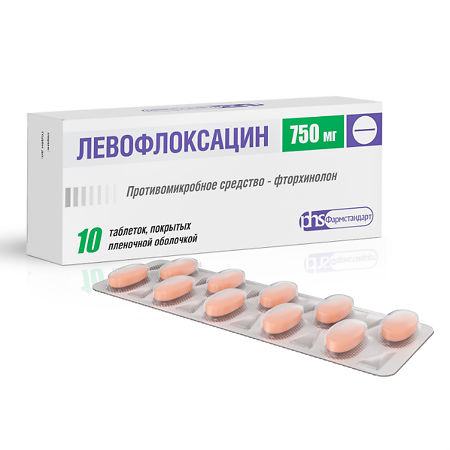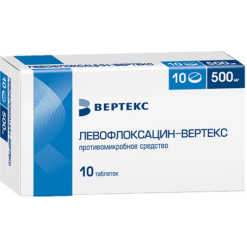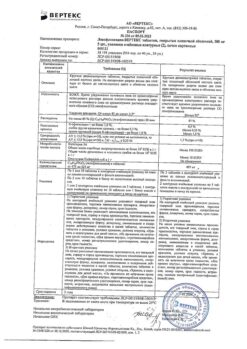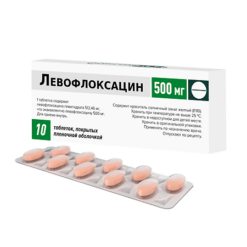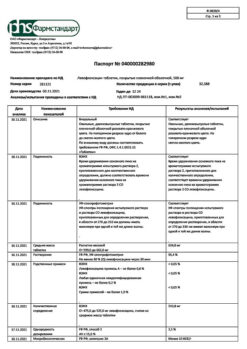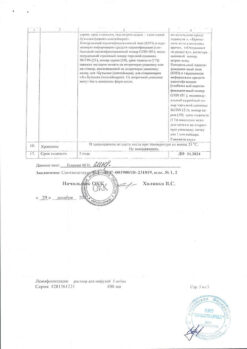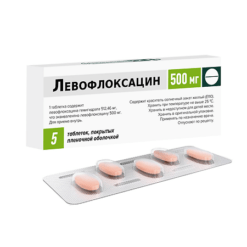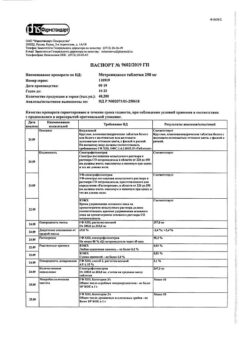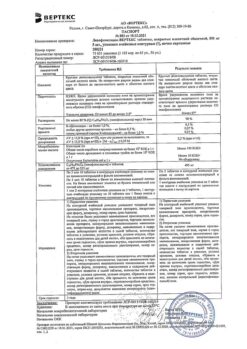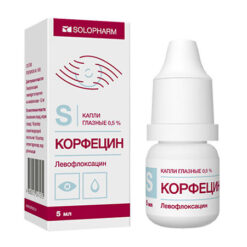No products in the cart.
Levofloxacin, 750 mg 10 pcs
€1.00
Out of stock
(E-mail when Stock is available)
Description
A broad spectrum synthetic antibacterial drug from the group of fluoroquinolones containing levofloxacin as the active substance – the left-handed isomer ofofloxacin.
Levofloxacin blocks DNA-giase, disrupts superspiralization and cross-linking of DNA breaks, inhibits DNA synthesis and causes deep morphological changes in cytoplasm, cell wall and membranes.
Levofloxacin is active against most strains of microorganisms (aerobic gram-positive and gram-negative, as well as anaerobic). Other microorganisms are also sensitive to Levofloxacin antibiotic: Bartonella spp, Chlamydia pneumoniae, Chlamydia psittaci, Chlamydia trachomatis, Legionella pneumophila, Legionella spp, Mycobacterium spp, Mycobacterium leprae, Micobacterium tuberculosis, Mycoplasma hominis, Mycoplasma pneumoniae, Ricketsia spp, Ureaplasma urealyticum
Indications
Indications
Levofloxacin in tablet and infusion solution form is indicated for the treatment of the following infections and inflammatory diseases caused by microorganisms sensitive to the action of its active substance: Acute sinusitis (tablets);
The exacerbation of chronic bronchitis (tablets);
Infections of soft tissues and skin (tablets);
/p>
Bacterial prostatitis; Community-acquired pneumonia;
Uncomplicated and complicated urinary tract infections, including pyelonephritis;
Bacteremia/septicemia associated with the above indications;
Intra-abdominal infections;
Drug-resistant forms of tuberculosis (infusion solution, concomitantly with other medications).
Active ingredient
Active ingredient
Composition
Composition
Levofloxacin – 500 mg (levofloxacin hemihydrate – 256.23 or 512.46 mg);
Auxiliary ingredients (tablets of 250 or 500 mg, respectively):
Microcrystalline cellulose, 30.83/61.66 mg,
hypromellose, 8.99/17.98 mg,
croscarmellose sodium – 9.3/18.6 mg,
polysorbate 80 – 1.55/3.1 mg,
calcium stearate – 3.1/6.2 mg.
Shell composition (tablets of 250 or 500 mg, respectively):
Hypromellose – 7.5/15 mg, hydroxypropyl cellulose (hyprolose) – 2.91/5.82 mg, talc – 2.89/5.78 mg, titanium dioxide – 1.63/3.26 mg, yellow iron oxide (yellow oxide) – 0.07/0,14 mg or film-coating dry mix (hypromellose 50%, hyprolose (hydroxypropyl cellulose) – 19.4%, talcum 19.26%, titanium dioxide – 10.87%, iron oxide (yellow oxide) – 0.47%) – 15/30 mg.
How to take, the dosage
How to take, the dosage
Orally, with meals or between meals, without chewing, drinking plenty of fluids.
The doses are determined by the nature and severity of the infection and the sensitivity of the suspected pathogen,
The recommended dose of the drug for adults with normal renal function (CK >50 ml/min):
In acute sinusitis, 500 mg once daily for 10-14 days;
In exacerbations of chronic bronchitis, 250 to 500 mg once daily for 7-10 days; In community-acquired pneumonia – 500 mg once or twice a day for 7-14 days;
In uncomplicated urinary tract and kidney infections – 250 mg once a day for 3 days;
In complicated infections of the urinary tract and kidneys – 250 mg once daily for 7-10 days;
In bacterial prostatitis – 500 mg once daily for 28 days;
In skin and soft tissue infections – 250 mg – 500 mg 1 or 2 times a day for 7-14 days;
Intraabdominal infections – 250 mg 2 times a day or 500 mg once a day for 7-14 days (in combination with antibacterials acting on anaerobic flora).
Tuberculosis – orally 500 mg 1-2 times a day for up to 3 months.
In case of liver dysfunction there is no need for special dose adjustment as levofloxacin is metabolized only slightly in liver and is excreted mainly by kidneys. If the medication is missed it should be taken as soon as possible before the next dose is due.
Then continue to take levofloxacin according to the regimen. The duration of therapy depends on the type of disease. In all cases, treatment should be continued for 48 to 72 hours after symptoms have disappeared.
Interaction
Interaction
There are reports of a marked decrease in seizure threshold with concomitant use of quinolones and substances that can, in turn, lower the cerebral seizure threshold. This applies equally to the simultaneous use of quinolones and theophylline.
The effect of Levofloxacin is significantly impaired when used concomitantly with sucralfate. The same occurs when concomitant use of magnesium- or aluminum-containing antacids and iron salts. Levofloxacin should be taken at least 2 hours before or 2 hours after taking these drugs. No interaction with calcium carbonate has been shown. When concomitant use of vitamin K antagonists it is necessary to monitor the clotting system. Excretion (renal clearance) of levofloxacin is slightly delayed by cimetidine and probenicid.
It should be noted that this interaction has almost no clinical significance. Nevertheless, when concomitant use of drugs such as probenicidin and cimetidine which block a particular excretion route (tubular secretion), treatment with levofloxacin should be conducted with caution. This applies especially to patients with limited renal function. Levofloxacin slightly increases the elimination half-life of cyclosporine. Administration of glucocorticosteroids increases the risk of tendon rupture.
Special Instructions
Special Instructions
In severe pneumococcal pneumonia, levofloxacin may not have optimal therapeutic effect. Hospital infections caused by certain pathogens (P. aeruginosa) may require combined treatment. During treatment with Levofloxacin, seizures may develop in patients with previous brain damage due, for example, to stroke or severe trauma. Despite the fact that photosensitization is very rarely observed during levofloxacin use, in order to avoid it patients should not be exposed to strong sunlight or artificial ultraviolet radiation without a special need.
If pseudomembranous colitis is suspected, levofloxacin should be stopped immediately and appropriate treatment started. In such cases, drugs that inhibit intestinal motility should not be used. Consumption of alcohol and alcoholic beverages during treatment with Levofloxacin is prohibited. Rarely observed during the use of the drug Levofloxacin tendinitis (primarily inflammation of the Achilles tendon) may lead to tendon rupture.
Elderly patients are more prone to tendinitis. Treatment with glucocorticosteroids likely increases the risk of tendon rupture. If tendinitis is suspected, treatment with Levofloxacin should be stopped immediately and appropriate treatment of the affected tendon should be initiated. Patients with glucose-6-phosphate dehydrogenase deficiency (hereditary metabolic disorder) may respond to fluoroquinolones by destruction of red blood cells (hemolysis). Due to this fact, treatment of such patients with levofloxacin should be performed with great caution.
Contraindications
Contraindications
Age under 1 year (eye drops), under 18 years (tablets and infusion solution);
Pregnancy and lactation;
Hypersensitivity to the components of the drug or to other quinolones.
Additional contraindications to the use of Levofloxacin in the form of tablets and infusion solution are: Tendon lesions with prior quinolone treatment;
Epilepsy;
Renal insufficiency with creatinine clearance less than 20 ml per minute (tablets);
p> Long Q-T interval (infusion solution);
Concomitant use with class IA antiarrhythmic drugs (quinidine, procainamide) or class III (amiodarone, sotalol) (infusion solution).
Side effects
Side effects
Itching and redness of the skin;
General hypersensitivity reactions (anaphylactic and anaphylactoid reactions) with symptoms such as urticaria, bronchial constriction and possibly severe choking;
Swelling of the skin and mucous membranes (e.g., in the face and pharynx);
sudden drop in blood pressure and shock;
hypersensitivity to sunlight and ultraviolet radiation;
Allergic pneumonitis; vasculitis;
Toxic epidermal necrolysis (Lyell’s syndrome);
erythema multiforme exudative;
Nausea, vomiting;
Diarrhea;
Loss of appetite;
abdominal pain;
pseudomembranous colitis;
decreased blood glucose concentration, of particular importance in diabetic patients (possible signs of hypoglycemia: increased appetite, nervousness, sweating, shivering);
aggravation of porphyria in patients already suffering from this disease;
Headache;
dizziness and/or dizziness;
drowsiness;
sleep disturbances;
restlessness;
trembling;
psychotic reactions like hallucinations and depression;
seizures;
p> confusion;
visual and hearing impairments;
impaired sense of taste and smell;
p> diminished tactile sensitivity;
Heart palpitations;
Joint and muscle pain;
tendon rupture (e.g., Achilles tendon);
worsening of renal function to the point of acute renal failure;
interstitial nephritis;
increased eosinophil count;
decreased leukocyte count;
neutropenia, thrombocytopenia, which may be accompanied by increased bleeding;
agranulocytosis;
pancytopenia;
fever.
Similarities
Similarities
Additional information
| Shelf life | 2 years |
|---|---|
| Conditions of storage | In a light-protected place at a temperature not exceeding 25 °C. |
| Manufacturer | Pharmstandard-Tomskkhimpharm, Russia |
| Medication form | pills |
| Brand | Pharmstandard-Tomskkhimpharm |
Other forms…
Related products
Buy Levofloxacin, 750 mg 10 pcs with delivery to USA, UK, Europe and over 120 other countries.

